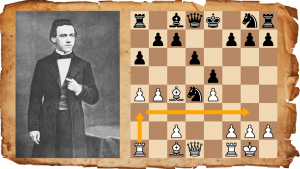
How To Defend Like Indiana Jones
A classic movie and literary ploy is when the hero must stay out of sight behind enemy lines, and decides to disguise himself as one of his foes. Students of classical literature might recall the ancient story about Achilles, the Greek hero of the Trojan war, who disguised himself as a girl at the court of the king of Skyros.
But personally, I can't help thinking of Harrison Ford, in the movie Indiana Jones and The Last Crusade, dressed up as a Nazi officer ("I hate these guys").

Despite our familiarity with the theme, hiding in plain sight (with a stolen uniform, for example) remains exciting and fun to watch or, indeed, to do. What's perhaps less known is that this trick also works quite well in chess!
Every beginner learns that the king should not stay in the center, and feels most comfortable behind his pawns on either the kingside or the queenside. We learn about castling and, later, the importance of making some "air" (the German term is Luft) for the king in order to avoid any bank-rank mates.
But hundreds of years ago, chess players already knew that sometimes, the king also feels quite safe behind the opponent's pawns! You don't believe me? Have a look at this early Indiana Jones example:
This is the earliest-known case where this motif can be observed in an actual game. But the concept that the king could also use the enemy pawns as a protective shield was already known more than 50 years before Philidor's time.
In the early 18th century, the Scottish chess player (and diplomat) Alexander Cunningham (1654-1737) introduced a new way to defend against the King's Gambit:
1.e4 e5 2.f4 exf4 3.Nf3 Be7 4.Bc4 Bh4+
Indeed a cunning way to prevent White's castling, even though after 5.Kf1!, White is actually doing fine. But the original variation went more spectacularly:
There it is again—the king hiding behind his opponent's pawn!
For a much more elaborate and nicely illustrated historical overview on this variation, I refer the interested reader to Batgirl's article.
Here's a former world champion using this method to protect his king, which, interestingly, also started from a King's Gambit.
The above example resulted not from the King's Gambit but from the King's Indian opening. In this opening, too, it appears that the defense with a king on h1 and a black pawn on h2 occurs as a standard method of play, especially in the so-called Mar del Plata variation (where White typically tries to win material on the queenside while Black is trying to mate on the kingside).
The following example is quite random, but I selected it because it is very straightforward and archetypical:
Rather more sophisticated than Philidor and Cunningham, but equally effective!
But the King's Indian isn't the only opening in which this defense occurs quite frequently. Another one is the Sicilian, where Black uses the opponent's h-pawn to protect himself from the attack.
In the following example, again pretty random, Vlastimil Hort deploys it successfully against yet another former world champ—the great Anatoly Karpov:
I've focused on defending with the help of the h-pawn. Certainly, it can also be done with the g-pawn, or any other pawn really. But I suspect that it's less effective, though, because the attacking side can still use the open h-file to place its pieces. This is not possible at the edge of the board. However, a similar defensive method can be applied successfully on the queenside, with the a-pawn.
Sometimes, it's best to hide in plain sight! You should give it a try, just like Indiana Jones and all those others. Have fun, but choose wisely!



